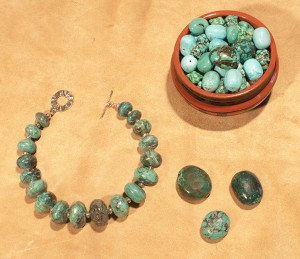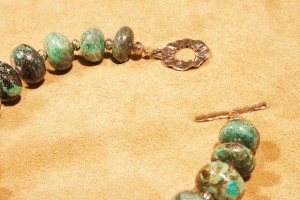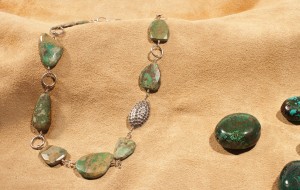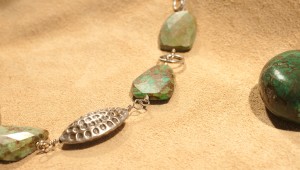
Turquoise is my first love when it comes to gemstones. At bead stores and gem shows, it’s impossible for me to walk past the turquoise. The sky-blues, robin’s egg blues and earthy greens and browns of the stone are irresistable. I think of it as the Native American gem because of the wonderful work done by Navajo, Zuni and other indigenous groups in the American Southwest.
I designed the necklace pictured above with simplicity in mind. It’s a substantial piece with large graduated turquoise rondelles and Navajo-made sterling silver beads as spacers. I bought the silver beads years and years ago from the late Bernie Weston who owned a shop called Skin and Bones on Yonge Street in Toronto.

I used a heavy hand-made sterling silver toggle clasp to complete this necklace – you can see it in this close-up.
Turquoise is actually one of the first gemstones to be mined. The ancient Egyptians some 70 centuries ago were carving jewellery out of turquoise and using it to decorate sarcophagi. A bracelet of carved turquoise and gold, the oldest known example of jewellery and dated as having been made over seven thousand years ago was found in the tomb of an Egyptian queen. In China, turquoise was also used in very early times and made into jewellery and decorative carvings as well as beads that were traded into Tibet and other countries. In the American Southwest, many of the mines were worked by the indgenous people in prehistoric times.
A number of years ago, I invited one of my yoga teachers and her then-husband, Kunga, a Tibetan healer to visit my community of Whitefish River First Nation. The visit was on Pow Wow weekend and I thought Kunga especially would enjoy the cultural experience that takes place at the foot of what is known as Dreamer’s Rock, a place where men of my community did their vision quests. Men, and women now, still do their vision quests, known as fasts, at Dreamers’ Rock in the spring and fall. At the end of the visit, Kunga presented me and several other women with wonderful turquoise jewellery that he’d made. I received a turquoise and pearl necklace with matching earrings and Kunga explained that his people highly revere turquoise because they believe it brings good health and good fortune and it dispels negative energy – good reasons to wear turquoise jewellery!

The design on the left is worked with sterling silver wire that connects the facetted, flat turquoise pieces. The stones I used are all unique shapes and sizes which I thought added interest to the design. I’ve also used some sterling silver rings and an accent bead.

The oval shape and the design of the sterling silver accent bead was remiscent of a turtle which made me decide it was perfect for inclusion in this necklace.
Turquoise represents strength and power and is said to be a stone of courage, fulfillment and success. It is considered a semi-precious gemstone. Turquoise is mined in the United States, China, Afghanistan, Australia and Iran.
Turtle Island
Speaking of turtles…In my last post, I said I would tell you why the turtle has a special place in the hearts of Anishnawbe (Ojibway) people. Other nations also have their own stories about the importance of the turtle. This is the Anishnawbe teaching.
We are told that after the creation of the world, Anishnawbe people lived together in harmony with all of Creation for a long, long time. Sadly, this did not last. There came a time when villages started fighting, families began quarrelling, brother turned against brother, and people began killing each other. It saddened the Creator, Gitchie Manitou, to see this evil. For a long time, Gitchie Manitou watched and waited, hoping the evil ways would cease and harmony would be restored.
When this did not happen, Gitchie Manitou decided to purify the Earth with water. The water rushed over the earth like a flood and most living things were drowned. Original Man, also known as Waynaboozhoo and thought to be more spirit than human, survived by resting on a huge log floating on the vast expanse of water covering Mother Earth. The few swimming animals and winged creatures who’d also survived joined Waynaboozhoo on the log. They floated for a long time but alas, could see no land. Finally, Waynaboozhoo told his friends he would swim to the bottom of the water and grab a handful of earth to create a new land. Waynaboozhoo dived down and after a long while, came back up sputtering to report that the water was too deep. The loon, helldiver, mink, otter and turtle all tried but they were as unsuccessful as Waynaboozhoo. All hope seemed lost. It was then that a little voice spoke up, so softly that at first no one could see who it was. Then little muskrat stepped forward and said, “I’ll try.” The animals laughed and jeered until Waynaboozhoo reminded them it was not their place to judge the merits of others.
Little muskrat dived down, disappeared from view and was gone for a long time. So long that everyone knew he’d given his life trying to reach the bottom. One of the aminals spotted muskrat as his body floated to the water’s surface. They pulled his body onto the log and Waynaboozhoo saw that muskrat had something in his paw. He gently pried open the tiny paw. There, in a little ball, was a piece of earth.
Waynaboozhoo took the piece of earth in his hand. Turtle swam forward. “Use my back to bear the weight of this piece of earth,” he said. “With the help of the Creator, we can make a new Earth.” The tiny piece of earth on the turtle’s back began to grow larger and larger until it formed an island in the water. Still, the Earth grew and still, the turtle bore its weight on his back, making life possible for the Earth’s second people. That is why Anishnawbe people call this place Turtle Island and give great honour to the turtle. [Adapted from The Mishomis Book, by Eddie Benton-Banai, 1988]
And Finally
Thank you – meegwetch – to everyone who’s visited my website, left comments or emailed me with ideas and compliments.
Leave a Reply